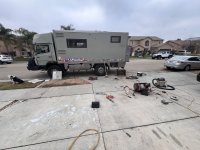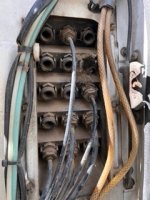The past month as been full of midl up and downs and adaptive changes.
Big thanks to Nate for letting me post up outside his house where he spent 2 days helping me try to sort of the generator issues. We started off with a volt meter. But somehow ended with reciprocating saws and cuts off wheels.

There was significant corrosion, rust, nesting, and all kinds of build up in the generator box. It took some work just to be able to get it out and access the wiring. The generator was later dropped of at a small engine shop where they did some maintain and repairs. There frame the holds up is rusted will need to be replaced by a fabricator. After leaving nate's house, I was driving in heavy rains and 10 minutes from a friend's house in NorCal. And the passenger window stopped working. The next day I tracked it down to a failed relay that was replaced. I'm still trying to track down the parasitic draw from the 24v side of things. It seems to be intermittent at times, which is frustrating.
Later, I met up in Tahoe with a buddy for some winter shredding. That was also met with challenges from weekend crowds, early season like coverage with a lot of terrain exposure. I must have been tempting fate as we disced helmet use. Took a digger into a rock and suffered a small scalp laceration. Got off the mountain, cleaned it, numbed it up, threw in the very minimal amount of sutures due to my impatience, and not being able to see the wound without an odd angles from mirrors. But I was back on the mountain within an hour and riding again (with a helmet)... Tobi also visited Tahoe and we were able to hit some breweries.



Afterwards, another week was spent in a rural ER covering some shifts before we made our way back to the PNW to chase to the snow storms.



But, after arriving and getting settled in at Steven's Pass. The Webasto heater failed again... So late at night, we drove over to Seattle in fear that the engine wouldn't start in freezing temps. We parked outside of Sure Marine Service and met the guys in the shop the following morning. Talk about feeling like a kid in a candy shop! They stock a lot of really cool ********! After talking to one of the techs, he had me pull the unit so we could bench test it. A few minutes later, he had found the combustion chamber was ******** and the glow plug wasn't working at spec. This is a great example of how it's often cheaper to buy it right the first time. This was a used/rebuilt unit I bought off of eBay for about $300. Walked in the shop just before 9 AM, had a repair, and reinstalled it by 11 AM. That was great service! We returned to Steven's pass, but unfortunately, at around midnight the heater would not kick on at all. Tried doing a few resets and couldn't get it to start. So we drove back to Seattle. The following morning, I checked voltage and the unit was getting 12.9-13.2 volts. Reset it again and it fired up.... It could be a mother board issue, but that felt like a voltage issue. We will see where it goes as I'm currently trying to do a PNW loop for snowboarding for the next month or so.
While at the shop, I these units also caught my eye:
https://www.suremarineservice.com/Heat/Fan-Heaters/
Anyone have experience with these? My habitat uses 2 radiators heat the leaving space. There is an additional, small radiator that heats and side hatch that stores some tools and spares. I'm thinking the plumbing there could be utilized for a unit like that and the blown air routed to the inside of the habitat. That would utilize a current system that doesn't provide heat and help with recovery when the temps drop.









